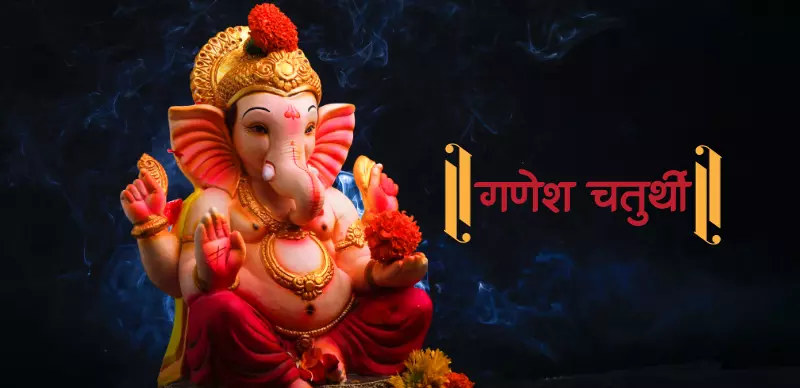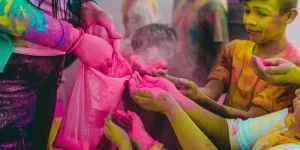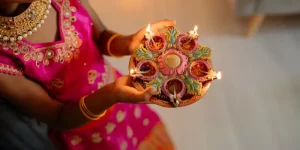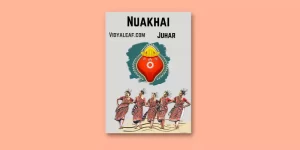Ganesh Chaturthi – Festivals and fairs are an intrinsic part of Indian culture, the medium of our beliefs and feelings. Each community has its own festivals and holidays but this doesn’t prevent other religious groups from enjoying the days of these festivals. Among those festivals, Ganesh Chaturthi is the biggest festival in the Hindu community, and this festival is grandly celebrated.
Om Vighneshwaray Varadaya Surapriya,
Lambodharaay Sakalaaya Jagaditaaya.
Om Naagaananaaya Shruti-Yagya
Vibhushitaaya,
Gauri Sutaaya Gana Naath Namo Namaste.
Ganesh Chaturthi
Ganesh Chaturthi otherwise called Vinayak Chaturthi is a Hindu festival celebrating the arrival of Ganesh to earth from Kailash Parvat with his mother Goddess Parvati or Gauri. It is celebrated to commemorate the birth anniversary of the elephant-headed deity Lord Ganesha, the god of prosperity and wisdom. It falls on the fourth (Chaturthi) day of the month of Bhadrapada (August – September).
Ganesh puja is one of the most widely celebrated Hindu festivals in the country and outside the country. The blessings of this God are invoked at religious ceremonies since he is the one who can turn all difficulties into success. Lord Vinayaka is known as the fortune giver and also the patron god of traveling. Ganesh is depicted with an elephant’s head on a human body.
The festival is considerable with the installation of Ganesh clay idols privately in homes and publicly by Shri Bal Gangadhar Tilak popularly known as Lokmanya Tilak in Pune in the year 1893 on elaborate pandals.
This festival is observed in states such as Chattisgarh, Gujrat, Tamilnadu, Madhya Pradesh, Andhra Pradesh, Maharastra, Karnataka, Rajasthan, Odisha, Goa, and West Bengal. Ganesh Chaturthi is also celebrated at Varasidhi Vinayaka Swamy Temple in Kanipakam, Andhra Pradesh, Annual Brahmotsavams will be celebrated for 21 days starting from Vinayaka Chaturthi Day.
It is also observed in Nepal, Australia, New Zealand, Canada, Singapore, Malaysia, Mauritius, South Africa, the United States, Europe, etc.
Story Behind Ganesh Chaturthi
The belief is set in the story of the birth of Ganesha, the son of Lord Shiva and Goddess Parvati. Even though there are several stories attached to his birth, the one most relevant is shared here.
Goddess Parvati was the creator of Lord Ganesha. In the absence of Lord Shiva, Goddess Parvati made a structure out of the turmeric paste she used to clean her body and put life into it. Hence, Lord Ganesha was born.
One day when Goddess Parvati was going to take a bath, she told Lord Ganesha to guard the door. While she was gone, Lord Shiva got into a fight with Lord Ganesha as he didn’t allow him to enter, as per his mother Parvati’s order. Enraged, Lord Shiva cut off Lord Ganesha’s head. When Parvati came out and saw this sight, she took the form of Goddess Kali and threatened to destroy the universe. This worried everyone and they asked Lord Shiva to find a solution and calm the rage of Goddess Kali.
Lord Shiva realized his mistake and sent his troops immediately into the forest to find the first animal that was lying with its head facing north. The first animal seen by the troops was an elephant and as they were ordered, cut his head and brought it to Lord Shiva. Lord Shiva immediately placed the head of the elephant on Ganesha’s body and brought him to life again. The anger of Maa Kali was calmed and Goddess Parvati was overwhelmed once again. Thus, Ganesha came to be known as God with an elephant head- son of Lord Shiva and Goddess Parvati.
Ganesha’s wisdom – A very popular story of Lord Ganesha tells us how he won a competition against his elder brother Lord Kartikeya in the most simple manner. Both the brothers often argued and fought with each other. In order to test them, Lord Shiva asked both the kids to take three rounds around the universe, and the one who finished first and returned to Mount Kailash would receive a special fruit of wisdom and knowledge. Kartikeya quickly jumped onto his peacock to fly around the universe but Lord Ganesha, short and stout, took the wise decision and sought permission from his parents to revolve around them, as he regarded them as his universe. Impressed by Ganesha’s wisdom, Lord Shiva gave him the fruit.
Ganesha and his one tusk – Ganesha is also called “Ekdant” which literally means one tooth. There are two stories behind this legend.
Ganesha and Parshurama – One day Parashurama, an avatar of Lord Vishnu, went to visit Lord Shiva, but along the way, he was obstructed by Lord Ganesha. Parshurama hurled himself at Ganesha with his axe and Ganesha allowed himself, out of respect for his father, to be hit and lose his tusk as a result. Thus, Lord Ganesha yells out in pain and Goddess Parvati comes running out of the cave. After knowing what has happened, she assumes the form of Goddess Kali and threatens to destroy the sage for his actions. Later Parshurama apologized to Lord Shiva and Goddess Parvati. Parshurama recited the Ganesha Naamaashtaka strata and pleased supreme Goddess Parvati. He requested Goddess Parvati to bring back the tusk of Lord Ganesha. Thus, Goddess Parvati fixed the tusk of Lord Ganesha.
Ganesha the Scribe – In the first part of the epic poem Mahabharata, it is mentioned that the sage Veda Vyasa asked Lord Ganesha to transcribe the poem as he recited it to him. Lord Ganesha agreed only on the condition that Vyasa deliver the poem uninterrupted, without pausing. The sage in order posed the condition that Lord Ganesha would not only have to write but would have to realize everything that he heard before writing it down. Thus, Vyasa might convalesce a bit from his continuous talking by simply reciting a difficult verse that Lord Ganesha couldn’t understand. As the dictation began, in the rush of writing Ganesha’s feather pen broke. He broke off a tusk and used it as a pen so that the transcription would proceed without interruption, permitting him to keep his word. Thus, Lord Ganesha became “Ekdant”.
The History of Ganesh Chaturthi
The festival was first celebrated publicly in Pune in 1892 by Bhausaheb Laxman Javale. In 1893, the Indian freedom fighter Lokmanya Tilak praised the celebration of Ganesh puja in his newspaper and dedicated his efforts to launching the annual domestic festival into a large well-arranged public event.
He recognized Ganesh’s appeal as the god for everybody. Robert Brown chooses Ganesh as the god that bridged the gap between Brahmins and Non-Brahmins. Tilak was the first to install large public images of Ganesh in pavilions in the Bombay Presidency and other celebratory events at the festival.
Festival
Public preparations for the festival begin months in advance. Local Mandapa or pandals’s usually capitalized either from donations by local residents or community organizations.
The making of the Murti in Maharashtra usually begins with worshipping the feet of Lord Ganesha. The Murti is brought to the pandal on the day or a day before the festival begins. The pandals have extravagant decorations and lighting.
At home, the festival preparation includes purchasing Ganesh idols, puja items, fruits, decorative items, etc. The murti is brought home either a day before or on the day of the Ganesh puja itself.
A small portion of the house is cleaned and decorated with flowers, colorful items, or lights before installing the Murti. When the idol is installed, it and its shrine are decorated with flowers and other items.
On the day of the puja, the ritualistic installation of the day Murti is done along with the chant of holy mantras during a definite auspicious period of the day.
In the consecration ceremony, a priest performs a Prana Pratistha, a ritual to invoke life in the idols, followed by Shhodashopachara, or the 16 ways of paying tribute. Amid the chanting of Vedic hymns from religious texts like Ganapati Atharvashirsa, Rigveda, and the Ganesh Srota from Narada Purana.
The idols are anointed with Red sandalwood paste and yellow and red flowers. Lord Ganesha is also offered Coconut, Jaggery, red hibiscus flower, Durva (Grass), and Modaks (sweet dumplings) considered to be Ganesha’s favorite food.
Visarjan
On the last day of Ganesh Chaturthi, the tradition of Ganesh Visarjan takes place. The finishing day of the 10-day festival is popularly known as Anant Chaturdashi. The Visarjan or immersion of the idol takes place in a river or sea. On the last day, the devotees come out in processions carrying the Murti of their beloved God and perform immersion.
There is an interesting story behind the legend of Ganesh Visarjan. It is believed that on the last day of the festival, Lord Ganesha returns to the Kailash Parvat to join his parents Lord Shiva and Goddess Parvati.
The celebration of Ganesh Chaturthi also indicates the significance of the cycle of birth, life, and death of Lord Ganesha, who is known as the Lord of New Beginnings.
It is believed that when the Murti is taken out for immersion, it also takes away with it various difficulties of the house, and these difficulties are destroyed along with Visarjan. Every year people eagerly wait with great anticipation to celebrate the festival of Ganesh Chaturthi.



